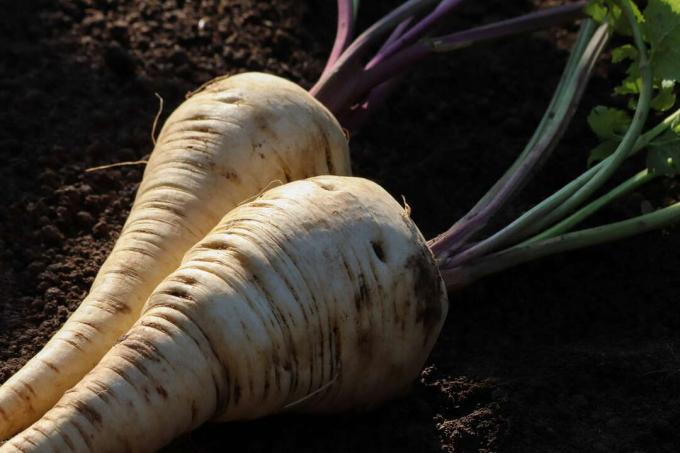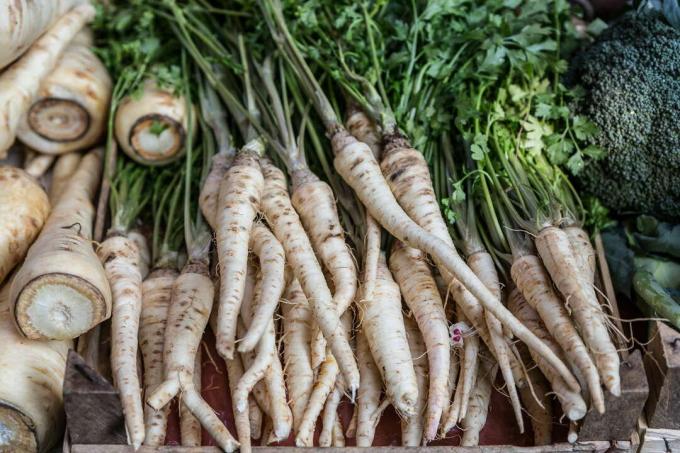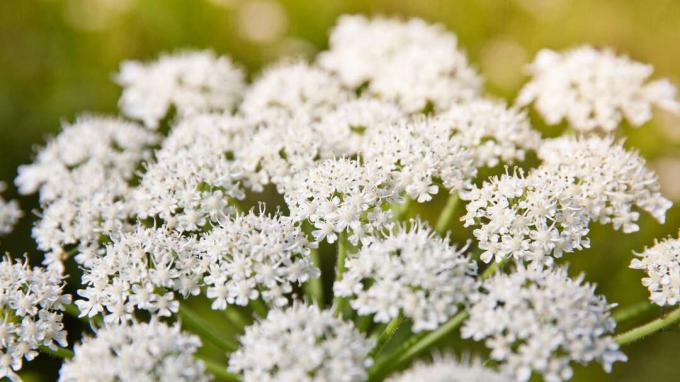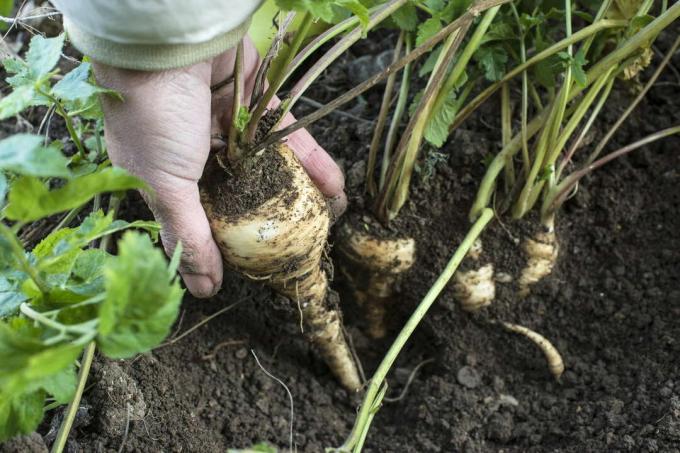The parsnip had long been forgotten. We want to make the root popular again and reveal what you have to consider when growing in the garden.

Parsnips (Pastinaca sativa) are becoming more and more popular right now. No wonder, because they contain valuable ingredients such as vitamins and minerals and can be used in many ways in the kitchen. So why not grow the long-forgotten vegetables yourself in the garden? We'll tell you everything you need to know about the cultivation of the aromatic root: From the origin and Various varieties, cultivation, care and utilization of parsnips can be found in this one Items.
First of all, we would like to inform you about the name of the trendy vegetable: Does it mean "the parsnip" or "the parsnip"? According to Duden, both are correct. In both cases, however, the majority is “parsnips”. In the past, the root was also called mutton carrot or bog root. That tells us who was the first to enjoy these vegetables: namely wild animals and farm animals. In addition to the culture form of the parsnip (
Pastinaca sativa subsp. sativa var. sativa) there is still the wild form Pastinaca sativa subsp. sativa var. pratensis. This grows on meadows, on fields or on fallow land.contents
- Origin and characteristics of parsnips
- Parsnip types & varieties
- Buying parsnips: what to keep in mind
-
Growing parsnips
- The perfect location for parsnips
- Growing parsnips: instructions
- Caring for parsnips: water and fertilize properly
- Harvest and store parsnips
- Ingredients, taste and uses of parsnips
In contrast to the cultivated parsnip, which forms a thick root, the root of its wild predecessor is much thinner. Both belong to the genus of parsnips (Pastinaca) and to the umbelliferae family (Apiaceae). Close relatives of parsnips are, for example carrot (Daucus carota subsp. sativus), dill (Anethum graveolens) or parsley (Petroselinum crispum ssp. crispum). The whitish-yellow root of the parsnip is therefore often confused with the parsley root. But parsnips are much more aromatic, sweeter and spicier than parsley roots.

The parsnip is a valuable food due to its high content of vitamins, minerals and essential oils. The possible uses in the kitchen are almost endless: as a puree, steamed, in the oven Braised or deep-fried into chips - the root always cuts a fine figure and tastes unique spicy. In naturopathy, both the roots and fruits as well as the dried leaves are used to provide help with stomach problems or fever, for example.
Origin and characteristics of parsnips
The parsnip originally comes from southern and central Europe and was already valued by the ancient Romans. From there it came to what is now Germany and Austria as early as Roman times. Charlemagne prescribed the cultivation of the nutritious root and the juice of the parsnip was used in times of plague even used as a cure for the Black Death, giving it the nickname "Pestinake". In the Middle Ages the parsnip had a similar status as the potato later in modern times: it was a staple food. Until the middle of the 18th In the 20th century, the root vegetable was highly valued in Germany, until it was used by the potato (Solanum tuberosum) and the carrot has been displaced.
In other parts of Europe - such as Great Britain, Scandinavia or the Netherlands - parsnip has never lost its popularity. What brought the vegetables back to German plates was actually organic farming: there the parsnip found more use again, so that it is slowly making its way back into our kitchens and gardens held. Parsnip has now become a real trend vegetable and is even found in gourmet kitchens. In 2011/12 she was voted “Vegetable of the Year”.
Parsnips are biennial plants that are usually only grown as an annual in horticulture. In the first year they develop an elongated turnip with a thickened top. This can be up to six centimeters thick and has a yellowish-white color. It can also weigh up to 1.5 kilograms and be up to 40 centimeters long. Usually it only forms flowers in the second year. In rare cases, the parsnip develops umbels on the stems of the plant, which are up to 120 centimeters high, in the first year. The foliage spreads a pleasant, aromatic-sweet scent. The leaves look similar to those of celery, are one to two-pinnate and have up to seven pairs of plumage.
Parsnip types & varieties
There are 14 known species of parsnip around the world that are common in Europe and Asia. However, only the only type of parsnip native to Central Europe is of interest for cultivation. Due to the increased cultivation in organic agriculture, new varieties of parsnip are being bred and further developed. We introduce you to some selected, tried and tested, old and new, promising varieties.

Which types of parsnips are particularly recommended?
- "White King": This old variety is characterized by rather short roots. Therefore, it is also suitable for growing on heavy soils.
- "Half white": Also a tried and tested variety that, as the name suggests, develops medium-long roots that are 20-30 cm long.
- "Aromas": This new variety impresses above all with its particularly sweet and nutty taste, but has less strength.
- "Mitra": This variety is also half-length and also particularly easy to care for.
- ˈHollow Crownˈ: A variety from England with roots around 30 cm long.
- "Thick Dern": The roots of this variety are more thick than long. Therefore, it copes well with heavier soils.
- ˈTurgaˈ: This variety is extremely frost-tolerant and can therefore remain in the bed until spring.
- "White Gem": This variety develops short, white roots and is also suitable for growing on heavy soils.
Buying parsnips: what to keep in mind
When buying parsnips, you need to decide whether you want to sow the vegetables yourself or buy ready-made young plants. It is not that easy to sow parsnips at the right distance. In addition, the plants must later be separated to the correct distance. It is therefore easier to acquire young plants that have already been grown. However, it should be remembered that plants are more expensive than seeds.
The choice of variety plays an important role when buying both the seeds and the plants. Buy a variety that will be easy to grow in your home location. When buying young plants, you should also make sure that the plants make a healthy and vital impression. The foliage should not be damaged. Also, you shouldn't see any signs of disease or pests on the plant. Smell the root ball as well to see if it smells foul. You can find young plants in nurseries, at the weekly market or on the Internet
What should be considered when buying parsnips?
- Decision between seeds and young plants
- Variety choice
- Healthy, vital young plants
- Free from pests and diseases
- No putrid smell

Growing parsnips
When you no longer want to be without parsnips on your plate, you have decided on a suitable variety and If you have already bought seeds or young plants, then there is nothing left to grow in your own garden Ways. We'll tell you where the parsnip feels most comfortable and give you instructions on how to grow the spicy root.
The perfect location for parsnips
The parsnip feels particularly good in your garden in a sunny or partially shaded location. You should pay special attention to the floor: you can go wrong here when growing parsnips. A well-drained, loose soil is ideal, in the best case a loamy sandy soil. The parsnip cannot cope with compacted, compact soils; in the worst case, the roots will branch out. Heavy soils should therefore be thoroughly loosened and sanded before cultivation.
In order for the root vegetables to develop their spicy aroma, they need a sufficiently humus-rich soil. If this is not the case for you, you should work plenty of compost into the soil before planting. It is also important to avoid waterlogging, as otherwise the roots will start to rot. In addition, the parsnips don't like it too sour - a pH value between 5 and 7 is ideal. Soils that are too acidic should therefore be limed before cultivation.
What location and soil requirements does the parsnip have?
- Sunny to partially shaded location
- Deep, loose soils
- Loamy sandy soils are ideal
- High humus content
- Uniform soil moisture
- No waterlogging or compaction
- pH value: 5.5 - 7
Growing parsnips: instructions
Parsnips can be grown for harvest between fall and winter. For this purpose, the seeds can be sown from mid to late March at the earliest. The latest sowing date is then at the end of June.

Tip: The ideal preculture for parsnips is one Green manurethat loosens the soil deeply. Are suitable, for example Lupins (Lupinus). However, you should avoid growing parsnips directly after other umbelliferous plants such as carrots, parsley, fennel (Foeniculum vulgare) or dill. Otherwise disease or pest infestation can increase. A waiting period of four years between the cultivation of umbellifers of all kinds is appropriate.
Prepare the bed well before sowing or planting by loosening it thoroughly and carefully. You should remove stones and weeds from the bed. You can get lean soils with one gift compost or with a fertilizer with organic long-term effects - like ours Plantura organic universal fertilizer - enrich to create the best growing conditions for the parsnips. As an alternative, you can use a high-quality, nutrient-rich vegetable soil, such as the Plantura organic tomato & vegetable soil, use. Now create seed grooves with a depth of two centimeters at a distance of about 35 centimeters.
The seeds are then placed at a distance of 10 to 15 centimeters and covered with soil. Then the seed is poured on and kept evenly moist. But be careful: the parsnips cannot tolerate too much moisture. Depending on the weather, parsnips germinate after two to three weeks. If the parsnips have been sown too closely, they can be separated after four to five weeks to a distance of 10 to 15 centimeters. Purchased young plants are also only planted as deep as they were in the pot with a row spacing of 35 centimeters and a plant spacing of 10 to 15 centimeters.
Step-by-step guide to growing parsnips:
- Loosen up the bed well
- Enrich with compost or a fertilizer with organic long-term effects
- Create seed grooves
- Seed depth: 2 cm
- Row spacing: 35 cm
- Plant spacing: 10 - 15 cm
- Pouring on
- Don't keep too moist
- Germination time: 2 - 3 weeks
- Possibly. scatter after 4 - 5 weeks

Tip: Parsnips can be grown very well in the bed with cut salads or radishes. These are ripe before the parsnips get really big. Onions are also good neighbors.
Caring for parsnips: water and fertilize properly
Parsnips have a relatively long cultivation period of 160 to 200 days. And with such a long time on the bed, of course, there is maintenance work to do. First of all, you should regularly clear the bed of weeds so that the parsnip can grow undisturbed and without competition.
Tip: Parsnip leaves are phytotoxic. This means that contact with the skin in connection with UV radiation can cause burns. Therefore, wear gloves when you take care of your parsnips.
Water your parsnips regularly so that the soil is evenly moist, but not wet. If the soil is too dry, the roots can burst. If, on the other hand, it is permanently too moist, the roots can start to mold. So check the soil moisture with your finger before watering.

Although the parsnip is one of the strong eaters, it does not have to be fertilized extensively. If there is too much fertilizer, the leaves tend to grow to unwanted heights, while the roots remain small. If you have enriched the soil with compost or a fertilizer with an organic long-term effect before planting, further fertilization is often not absolutely necessary. A second dose can be given when the plants are about 10 to 15 centimeters high. Then you can ideally re-fertilize with a fertilizer with organic long-term effect in small amounts. Our Plantura Organic universal fertilizer is ideally suited for this, as the nutrients are slowly and gently released to the plant and the soil life is also supported by the fertilizer. This in turn ensures a good soil structure, which is particularly important for root vegetables.
How is the parsnip properly cared for?
- Weed weeds regularly
- Keep soil moist, but not wet
- Apply fertilizer or compost before planting
- Fertilize again when the plants are 10-15 cm high
Harvest and store parsnips
From October, after 180 to 200 days in the bed, the first parsnips can be harvested. The easiest way to do this is with a digging fork. Use it to gently loosen the soil, then you can carefully pull out the parsnips. With 30 plants per square meter, the harvest yield is around six to eight kilograms. From the harvested parsnips, cut the foliage to about an inch.
Tip: The green of the parsnips can also be used fresh in the kitchen. Do not throw it away, but try it as a condiment for soups, sauces or salads, for example.
The harvested roots feel most comfortable at around 0 ° C, with high humidity and lightly covered with sand. This works well in a cellar with sand, for example. This way, the roots will last long into next spring. But since the roots are completely hardy, you can simply leave your parsnips outside in the bed and harvest them fresh whenever they are needed. But who has bad experiences with Voles or made mice, it is better to take the parsnips out of the ground in autumn. They are a real treat for the unwanted rodents in winter.

tip: The longer the parsnips are stored, the tart the taste. If you want to avoid this, you can also freeze the roots. To do this, they are cut into strips or cubes, blanched briefly and then frozen, depending on your taste.
How are parsnips harvested and stored?
- All winter long from October
- Carefully loosen the earth with a digging fork
- Pull out parsnips
- Cut off foliage
- Store in the basement covered with sand
- Make sure there is sufficient humidity
- Or blanch and freeze
If you want to get your own parsnip seeds, it's child's play. Select some vigorous plants for seed propagation and leave them on the bed for the winter. Parsnips that have flowered in the first year are not suitable for seed production. The parsnips that bloom in the second year later bear large, germinable seeds. The best time to harvest the seeds is when the umbels turn yellow to light brown. Then dry the seeds for a few days and store them in a dry, cool and dark place until the next year.
Ingredients, taste and uses of parsnips
No wonder that parsnips are becoming more and more popular, because their ingredients are impressive: they contain four times as much fiber, potassium, protein and vitamin C as carrots. In addition, there are only 59 calories in 100 grams of parsnips.
100 grams of parsnips contain:
- 82 g of water
- 523 mg of potassium
- 47 mg calcium
- 82 mg of phosphorus
- 18 mg of vitamin C.
Other ingredients of the great root are also bergapten, xanthotoxin and Imperatorin. Their low nitrate content is also remarkable. In terms of taste, the root is most likely between carrot and celery. It tastes mild, somewhat sweet, very spicy and sometimes also bitter. The roots are great for soups and purees. Parsnip puree can be prepared in the same way as mashed potatoes.

The vegetables are also delicious baked in the oven with other root vegetables and potatoes and served with a herb dip. But parsnips also taste very good raw and spice up any salad. Nowadays, parsnips are increasingly being used as an alternative to potato chips: Fried parsnip chips are a delicious snack. In addition, a thick syrup can be cooked from the parsnip roots, which can be used as an alternative sweetener. And parsnips are also used in herbal medicine. The roots are said to have a diuretic effect and thus stimulate the appetite.
